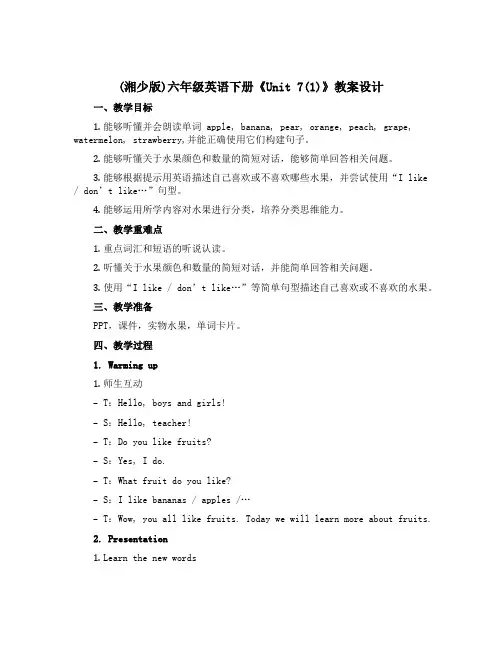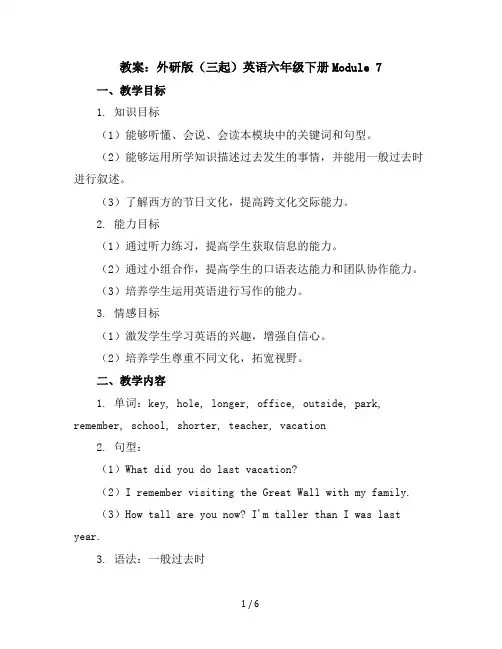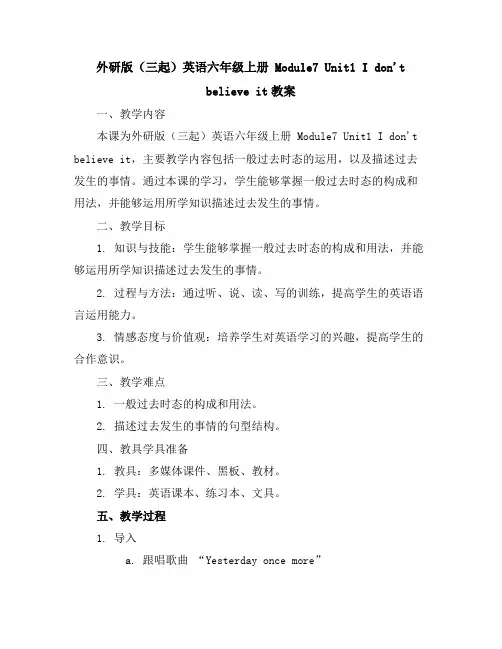六年级英语第七模块教案(1)
- 格式:doc
- 大小:1.67 MB
- 文档页数:10

Lesson plan for Module7 Unit1(I don’t belive it!)Background information:Students: Luxun primary school students, Grade 6Lesson duration: 40 minsTeaching materials: Module 7, Unit1 I don’t believe it!English Book 7, Foreign Language Teaching and Research Press Type of the lesson: Listening and speakingTeaching Aims:Knowledge aim: By the end of the class, students will be able to:1. Learn some new words: believe, lucky, bamboo, CD-ROM, copy, and can write the word day.2. Pronounce the word say and says/a: / correctly.3. Understand the new stentences well: Pandas eat for twelve hours a day.Do snakes like music?Ability aim: By the end of the class, students will be able to:1. introduce animal’s features by using the sentence (Pandas eat for twelve hoursa day.) in oral expressions.2. use the sentence (Do snakes like music?) to ask whether their conjecture about animals is right.Emotion aim: Cultivate students’ interest in Chinese eating habit.Learning strategies:1. Individual learning strategy: learn new words with pictures.2. Cooperative learning strategy: work with partner or group members.Focal points:1. Key vocabulary—healthy, orange, drink, fruit, vegetable, beef, carrot, chicken,juice, melon, milk, onion, pork, potato, tomato2. Key structures—have / has gotDifficult points:1. The usage of have / has got.2. The singular, plural,and uncountable form of nouns.Teaching Methods: Bottom-up approach to listeningTeaching model: The 3-stage modelTeaching aids: pictures, recorder, tape, PPT, chalks, blackboard.Teaching ProcedureLead-in(4 mins)Teacher begins the lesson by showing the students pictures of food and asking questions, “Are you hungry now?” “When we are hungry, what can we do?” “When w e are thirsty, what can we do?” to lead in the topic Healthy Food.Step 1. Pre-listening(11mins)1. Write the words food and drink on the blackboard.2. Ask a student “What did you eat yesterday?” in order to classify the food into3 kinds, fruit, vegetable and meat. Blackboard layout as follow,3.Ask students “What’ the food?” students may repeat“Fruit, vegetables andmeat are food.”4. Ask students “What fruit/ vegetables/ meat/ drink do you know?”, and writetheir answers on the blackboard. When talk about juice, explain the expressions of different kinds of juice.(e.g. apple juice)5. Ask students to open their book and finish the three activities(Activity 1,2, 3) individually. Then call back the answers from the whole class as complete sentences.(e.g. Picture 1 is fruit, and in picture 1 there is an apple, a melon and an orange.)Activity 1 Work in pairs. Match the words with the pictures.Answersfood: 1;2;3 drink:4Activity 2 Label the food in the pictures with these words.Answersfruit:1 meat:3 vegetables:2Activity 3 Label the food and drink with these words.Answersa. melonb. applec. oranged. chickene. porkf. beefg. tomato h. potato i. carrot j. onion k. water l. milk m. Juice6. Explain and show the singular, plural, and uncountable form of nouns. Then askstudents to write the plural form near the words on P26, Ativity 1, and then askstudents to read the words on PPT.Step II. While-listening(15mins)1. Do Activity 4①. Teacher ask “Do you know Betty? What Betty and her mother have got?” then play the recording and ask students to focus on the shopping list.②. Play the recording again for them to check. Call back the answers from the wholeclass.③. Ask students work in pairs and make dialogue.(e.g. A: Have they got any apples?B: Yes, they have.)Answersoranges√ beef × onions × apples√ pork carrotsmelons× tomatoes√ milk chicken√ potatoes√ juice2. Do Activity 6①. Ask students to read the four sentences in Activity 6 silently, then one studentto read loudly.②. Play the recording for the students.③. Call back the answers from the whole class.Answers1. juice2. meat3. Yes, they have.4. No, they haven’t.④.Play the conversation again and pause after each phrase, point out the grammarpoint.⑤. Ask students to read these dialogues after the tape individually, and thenputthem into groups of four to practice the dialogue.Step III. Post-listening1.Do Activity 7(10mins)①Play the recording once without stopping.②Play the recording again and stop at the end of each line. Ask the whole classto repeat.③Ask students to practice in pairs.2.Do Activity 8. Choose six words in Activity 4. Work in pairs and makedialogues.①Ask students to choose six words secretly and not tell anyone.②Read the example with the class. Then pair them to make dialogues..③Ask some pairs of them to present the dialogues.Homework: Practice the conversation in Activity 5 and sounds in Activity 7.Blackboard Layout: key words and sentences。

(湘少版)六年级英语下册《Unit 7(1)》教案设计一、教学目标1.能够听懂并会朗读单词 apple, banana, pear, orange, peach, grape, watermelon, strawberry,并能正确使用它们构建句子。
2.能够听懂关于水果颜色和数量的简短对话,能够简单回答相关问题。
3.能够根据提示用英语描述自己喜欢或不喜欢哪些水果,并尝试使用“I like / don’t like…”句型。
4.能够运用所学内容对水果进行分类,培养分类思维能力。
二、教学重难点1.重点词汇和短语的听说认读。
2.听懂关于水果颜色和数量的简短对话,并能简单回答相关问题。
3.使用“I like / don’t like…”等简单句型描述自己喜欢或不喜欢的水果。
三、教学准备PPT,课件,实物水果,单词卡片。
四、教学过程1. Warming up1.师生互动–T:Hello, boys and girls!–S:Hello, teacher!–T:Do you like fruits?–S:Yes, I do.–T:What fruit do you like?–S:I like bananas / apples /…–T:Wow, you all like fruits. Today we will learn more about fruits.2. Presentation1.Learn the new words–apple /banana / pear / orange / peach / grape / watermelon / strawberry–让学生跟读并认读。
2.Listen and match–让学生听音频,将图片和单词匹配。
–再放一遍让学生检查自己的答案。
3.Look and say–让学生看图片,学习表达颜色和数量。
•T:How many apples do you see?•S:I see two apples.–让学生模仿老师读句子。

教案:外研版(三起)英语六年级下册Module 7一、教学目标1. 知识目标(1)能够听懂、会说、会读本模块中的关键词和句型。
(2)能够运用所学知识描述过去发生的事情,并能用一般过去时进行叙述。
(3)了解西方的节日文化,提高跨文化交际能力。
2. 能力目标(1)通过听力练习,提高学生获取信息的能力。
(2)通过小组合作,提高学生的口语表达能力和团队协作能力。
(3)培养学生运用英语进行写作的能力。
3. 情感目标(1)激发学生学习英语的兴趣,增强自信心。
(2)培养学生尊重不同文化,拓宽视野。
二、教学内容1. 单词:key, hole, longer, office, outside, park, remember, school, shorter, teacher, vacation2. 句型:(1)What did you do last vacation?(2)I remember visiting the Great Wall with my family.(3)How tall are you now? I'm taller than I was last year.3. 语法:一般过去时4. 功能句:What did you do yesterday? I stayed at home yesterday.三、教学重点与难点1. 重点:单词的准确拼读和意义,句型的运用。
2. 难点:一般过去时的运用,描述过去发生的事情。
四、教具与学具准备1. 教具:多媒体课件、录音机、磁带。
2. 学具:课本、练习册、单词卡片。
五、教学过程1. 热身(5分钟)(1)教师与学生用Hello, good morning等问候语进行互动。
(2)引导学生回顾上一模块学过的内容,为新课的学习做好铺垫。
2. 引入(10分钟)(1)教师通过提问方式引导学生思考过去的事情,如:"Whatdid you do last week?"。

六年级上册英语教案-Module 7|外研社(三起)教学内容本模块的主题是“Festivals and Celebrations”,教学内容主要围绕中西方的节日和庆祝活动展开。
通过学习,学生能够了解和掌握关于节日和庆祝活动的英语词汇和表达方式,如“festival”, “celebration”, “custom”等。
同时,学生能够用英语描述和讨论节日和庆祝活动的时间、地点、方式和习俗等。
教学目标1. 知识目标:学生能够掌握关于节日和庆祝活动的英语词汇和表达方式,能够用英语描述和讨论节日和庆祝活动的时间、地点、方式和习俗等。
2. 能力目标:学生能够通过听、说、读、写的训练,提高英语综合运用能力,能够用英语进行简单的交流。
3. 情感目标:学生能够通过学习,增强对中西方文化的了解和尊重,培养跨文化交际的意识。
教学难点1. 英语词汇的掌握和运用,如“festival”, “celebration”, “custom”等。
2. 英语句型的构建和运用,如描述节日和庆祝活动的时间、地点、方式和习俗等。
3. 中西方文化差异的理解和尊重。
教具学具准备1. 多媒体教学设备,如投影仪、电脑等。
2. 教学课件,包括图片、音频、视频等。
3. 教学卡片,包括单词卡片和句型卡片等。
4. 学生用书和学习材料。
教学过程1. 导入:通过图片或视频,展示中西方的节日和庆祝活动,引发学生的兴趣和好奇心。
2. 新课导入:通过讲解和示范,教授关于节日和庆祝活动的英语词汇和表达方式。
3. 练习:通过听、说、读、写的训练,让学生掌握和运用英语词汇和表达方式。
4. 交流:通过小组讨论或角色扮演,让学生用英语描述和讨论节日和庆祝活动。
板书设计1. Module 7 Festivals and Celebrations2. 关键词:festival, celebration, custom, time, place, way, tradition3. 句型: What festivals do you know?When is the festival celebrated?Where is the festival celebrated?How is the festival celebrated?What are the customs of the festival?4. 图片或图表:展示中西方的节日和庆祝活动。

外研版(三起)英语六年级上册 Module7 Unit1 I don'tbelieve it教案一、教学内容本课为外研版(三起)英语六年级上册 Module7 Unit1 I don't believe it,主要教学内容包括一般过去时态的运用,以及描述过去发生的事情。
通过本课的学习,学生能够掌握一般过去时态的构成和用法,并能够运用所学知识描述过去发生的事情。
二、教学目标1. 知识与技能:学生能够掌握一般过去时态的构成和用法,并能够运用所学知识描述过去发生的事情。
2. 过程与方法:通过听、说、读、写的训练,提高学生的英语语言运用能力。
3. 情感态度与价值观:培养学生对英语学习的兴趣,提高学生的合作意识。
三、教学难点1. 一般过去时态的构成和用法。
2. 描述过去发生的事情的句型结构。
四、教具学具准备1. 教具:多媒体课件、黑板、教材。
2. 学具:英语课本、练习本、文具。
五、教学过程1. 导入a. 跟唱歌曲“Yesterday once more”b. 老师出示一张图片,描述图中发生的事情,引导学生关注过去时态。
2. 新课展示a. 老师创设情境,展示本课的主要句型。
b. 学生跟读并模仿句型。
3. 趣味练习a. 学生两人一组,用一般过去时态描述过去的事情。
b. 老师邀请几组学生上台展示,并给予评价。
4. 巩固提高a. 老师出示一些图片,学生用一般过去时态描述图片中的事情。
b. 学生互相交换练习,互相评价。
5. 课堂小结b. 学生分享学习收获。
六、板书设计1. 课程外研版(三起)英语六年级上册 Module7 Unit1 I don't believe it2. 重点句型:一般过去时态的构成和用法,描述过去发生的事情的句型结构。
3. 课堂活动安排:导入、新课展示、趣味练习、巩固提高、课堂小结。
七、作业设计1. 听力练习:听懂并能够复述本课的对话内容。
2. 口语练习:用一般过去时态描述过去的事情,不少于5句话。

Module7unit 1 Pandas love bamboo教学设计教学目标:1.知识目标:引导学生运用一般现在时的句子介绍动物习性。
2.技能目标:学生通过小组合作,组内讨论,组间交流,培养学生自主学习和运用语言的能力。
3.情感目标:通过了解动物与人类的和谐关系,激发学生热爱动物的情感和自觉保护动物的意识教学重点:They love .... They like ....They sleep in the water. They play with children.What are they? They are ....难点:能用所学的句型谈论动物及其习性。
课时:1课型:新授教学准备:tape, cards, bag学情分析:小学生都具有好奇、好玩、好动、好表现、好表扬等心理特点,同时对新奇的事物非常感兴趣。
高年级学生也具备了一定的合作能力和参与意识,在一定的情境中,学生能够积极的参与、大胆表达、勇于合作,展现出良好的学习氛围。
教教学设计Step1: Warmer1.Greetings.2.Sing a song “Old MacDonald has a zoo.”3.引出动物猴子、猫、大象、熊猫进行复习.T: Cats, dogs, pandas lions, we call them animals. Do you like animals?What's your favourite animal? (课件展示动物园里各种动物,让学生变用英语说出自己最喜欢的动物)Ss: ...T: My favourite animal is panda. Tell me more about pandas?What do pandaslike to eat? Yes, they like bamboo. Sometimes they eat fish, fruits,vegetables. But we know pandas like to eat bamboo. Pandas love bamboo.Today we are going to learn Module 7 Unit 2 Pandas love bamboo.引出本课课题并板书课题。

Module 7Unit1.I don’tbelieve it!第一课时一、教学内容外研版小学英语六年级上册第七模块第一单元第一课时:Unit 11.Look, listen and say.2.Listen, readand act out.二、教学目标1.大多数学生能够听、说、读、写单词或短语:believe, snake, DVD, lucky, bamboo, its, body, come out of, flute, get frightened.2.大多数学生能够听懂并用句型:I don’t believe it! Do snakes love music?3.能够运用所学的语言知识与同伴进行交流。
三.重点难点重点:1.听、说、读、写单词和短语:believe, snake, DVD, lucky, bamboo, its, body,come out of, flute, get frightened.2.学习句型:I don’t believe it! Do snakes love music?难点:1.能用一般现在时描述动物的习性。
2.一般现在时的构成和变化。
四.教学准备。
1.单词卡片。
2.P PT课件。
五.教学过程。
Step 1. Warm up.Free talkT: Today we are going to know moreabout animals facts from Module 7.Unit 1.Now let’s guess some riddles aboutanimals.(1)They are long .They have gotsmall heads. They have got nolegs. What are they?(snakes)(2)They are fat. They are black andwhite. They live in China. Whatare they?(pandas)Step 2.Preview.复习Module 7单词表的单词,提问拼背。

Module 7 Unit1 I don’t believe it!教学目标(一)知识目标:1.能识读并运用单词:believe,lucky, bamboo, dangerous, frightened fantastic。
2.能灵活运用一般现在时描述事物。
(二)能力目标:1.学生能够灵活运用本课的功能语句在真实的语境中描述事物。
(三)情感目标:1、学生进一步了解动物的生活习性。
2、让学生懂得保护动物,珍爱生命。
教学重难点:(一)重点:believe, bamboo(重读), dangerous, frightened , fantastic(重读)(二)难点:say –says(读音变化)能熟练运用一般现在时描述事物。
教具准备:PPT , fantastic小贴画,单词卡、简笔画教学过程:Step一、warming up ---guess:1.给学生出示一些描述动物的句子,让学生猜测是哪种动物。
1)They climb trees very fast.They like bananas.What are they?2)They are cute.They are white and black. What are they?3)They have long nose and bid eyes. What are they?2.给学生出示snake和panda的图片及相关句式提示,让学生在原有认知上描述两种动物。
(这两个练习初涉本课主题动物习性,一方面让学生回忆动物相关知识,另一方有利于导入课文教学)T: Pandas can climb trees. Do you believe it?Pandas eat meat. Do you believe it?利用动物习性引导学生使用believe。
引出本课主题 I don’t believe it!Step二、导入课文Daming has got a present from his Grandma. What is it?利用点读笔点读一遍课文,回答问题。

Module7 模块整体教案模块教材分析本模块的主题是“Animal facts’’。
它是以学生喜欢的话题“动物习性”为主要教学内容。
通过本模块的学习,学生能用英语向他人描述某些动物的生活习性,以及能向他人询问动物的生活习性。
能将语言内容转化为实际交际。
让学生了解大明所说的令人难以置信的事情到底是哪些。
通过教师的讲解和对课文的学习,能够理解并运用动词第三人称单数,为第八模块的学习奠定基础。
重点句型有:Pandas eat for twelve hours a day. They love bamboo. Do snakes like music? I like... He likes... We like...及否定句。
相关的词汇和短语有:believe, snake, DVD, lucky, bamboo, its, body, come out of, flute, get.教学内容主要是围绕着主人公Darning从DVD中了解了蛇和熊猫的一些习性,引出主要知识而展开的一系列对话和练习活动。
教学的重心应放在让学生学会用一般现在时表达人物或动物的喜好。
模块教学目标☆知识目标1. 能理解并会听说Unit 1 Activity 1 Look, listen and say. Activity 3 Listen and say. Activity 4 Practice. & Unit 2 Activity 1 Look, listen and say. Activity 5 Listen and say. Then chant.中的单词和句子。
2. 能听、说、读、写Unit 1 Activity 2 Listen, read and act out.中的单词和句子。
3. 能听说、认读Unit 2 Activity 2 Listen and read.中的句子。
4. 能理解Unit 2 Activity 3 Read and complete.中的单词和句子。

Module7 Unit1 参考教案一、教学内容外语教学与研究出版社(一起点)六年级上册第七模块Unit 1 Pandas love bamboo.二、教学过程建议(一)热身导入1. 请学生说SB Module 6 Unit 2活动4的韵句。
2. 播放SB Unit 1活动1的动画或录音,请学生看动画或边听录音边看挂图,理解语境:Darning问Simon蛇爱听音乐吗,Simon说他不知道。
Darning又问Simon 他的狗爱听音乐吗,Simon一看,原来他的狗正在咬他的CD !3. 再次播放录音,请学生全班跟读、小组跟读、个人跟读。
4. 最后请部分学生展示对话。
(二)任务呈现教师对学生说:“Simon的狗为什么咬他的CD? 因为狗总是喜欢咬东西,比如啃骨头,这是狗的生活习性。
同学们一定知道不少动物的生活习性吧?我们今天的任务就是说一说自己知道的动物的生活习性,看一看谁对动物的生活习性了解最多。
在这之前,我们先来学习课文,看一看Darning 了解到了哪些动物的生活习性。
”(三)课文学习1. 播放SB Unit 1活动2的动画或录音,请学生看动画或边听录音边看挂图。
教师帮助学生理解课文语境。
2. 再次播放录音,请学生完整听一遍对话,进一步理解语句。
播放第三遍录音,请学生逐句跟读。
对于学生跟读有困难的语句,教师先带读较难词语,然后按照意群、节奏重点带读,请学生注意模仿语音语调。
3. 在跟读过程中,通过展示图片、做动作、说明等方式,学习“bamboo, gave, its, almost, deaf, frightened” 的语义,并对“gave, its” 进行运用训练。
4. 请学生观察、分析、归纳对话中的行为动词一般现在时的特点及基本用法,并适当扩展到其他人称。
5. 完成AB Unit 1练习1。
这是课文阅读理解练习。
教师引导学生理解练习要求:根据课文内容和答句,写出问句。
先请部分学生朗读答句,再请全体学生完整地阅读一遍课文,根据课文内容和横线下方的答句,在横线上写出相应问句。

外研版三起六年级英语下册Module 7 Unit 1 教案教学目标1.学生能够听懂并口头表述有关地图上的不同城市和国家的位置。
2.学生能够使用询问和回答的方法交流有关地理位置的信息。
3.学生能够展示出他们的地理知识,并且能够在学习之后进行实践运用。
教学准备•PowerPoint展示文稿。
•地图实景展示。
•小组合作活动的支持材料。
•白板和马克笔。
教学流程Part 1: 热身 (5分钟)首先,老师可以用外部渲染插件来展示一张世界地图,然后通过询问学生位于哪个城市或国家等问题,热身并固化学生的基础地理知识。
Part 2: 学生互动 (10分钟)学生们被分成小组,每组5人。
每个小组会被分配到一个不同的国家和城市。
老师给每个小组一幅地图和一些问题要求学生点出他们的城市所在的位置,并在地图上标注出来。
然后让小组互相交换自己标注的图,用他们复习的知识来寻找对方所标注的城市和国家的位置,并在地图上进行标注。
学生们需要相互协作完成任务。
Part 3: 语音练习 (15分钟)通过一个语音小练习,老师可以帮助学生扩大他们在地理方面的视野。
老师可以播放一段录音让学生听到不同的城市和国家的发音,并让学生跟着老师的读音进行练习。
Part 4: 放映 (20分钟)现在,老师可以使用PowerPoint展示文稿,来展示一段有关地理位置的视频。
根据录音或视频,学生们在他们的地图上标出不同的城市和国家的位置,在提交之前进行小组内部的检查。
Part 5: 小组合作 (20分钟)让同组的学生们进行小组合作,他们需要合作进行环球赛车比赛,并且在地图上标注出比赛中的位置,同时需要回答问题,如“哪个城市里的时间更早?”或者“最后一个检查站靠近哪个城市?”等等。
学生需要依据自己已学的知识,在规定时间内完成任务。
Part 6: 总结 (5分钟)现在,让学生进行自我检查,检查他们在任务执行的过程中,有没有新的认识,这些认识和学生在之前的互动环节中的认识有没有不同,并且需要总结道学生的记忆中。
新标准英语(小学一起)六年级上册Module7 教学设计Q3: How does Daming like it?2.听录音,回答问题。
组内学生一起学习整个对话,然后回答问题,随后一起检查答案。
并教授新单词:gave ,frightenedQ4: How long do pandas eat every day?Q5:What do they love to eat?Q6:Do snakes like music? Q7:Why is the snake coming out of the box?3. 朗读对话用不同的方式读对话。
你们做的太棒了!现在谁能当大明和奶奶?并把对话表演出来?学生自己来问答问题。
并学习新的单词gave,frightened.用不同的方式进行阅读。
表演对话。
让学生带着问题第二次听音,小组内讨论解决问题,从而让学生理理frightened这些单词。
学生通过小组合作,以不同的形式朗读课文(齐读,分段读,分角色读),对于学习能力强的小组,可以通过表演的形式来展示,通过这种阶梯形的朗读,给不同的学生提供不同的空间,让每个孩子都有展示的机会。
Step 4:语法T:现在,我们来试着拖拽这些学生开始做联系语法是小学英Step 1:热身(10分钟)1)师生问好。
2)说韵律诗:I like coffee. I liketea. I like cats andthey like me. Daminglikes monkeys. Simonlikes sheep. We likethem and they arehappy.3)复习:游戏击掌传话:A: I like cats. Thecats like fish. Do youlike cats?B: 1) Yes, I do. Ilike cats. The catslike fish.2) No, I don’t. Ilike... ...like...A: Which animal do youlike? 与老师问好。
外研版(新标准)六年级第七模块Module 7 Unit 1 Shenzhou V flew into space.教案及教学反思外研版(新标准)六年级第七模块Module 7 Unit 1 Shenzhou V flew into space.教案及教学反思1. 语言功能:谈论发生过的大件事。
2. 语言结构:含有动词过去时形式(不规则变化)的陈述句学情分析六年级的学生,已有多年英语学习的经历。
对于过去时的认识和理解,学生在此之前的学习活动中已经有一定的基础,学生能够把握一般过去时的概念及含义。
但是对于不规则动词的变化及运用含有过去时形式的词句。
理解和运用动词过去时的特殊变化形式,以及阅读技巧在存在一定的困难。
通过本课教学意图使学生进一步巩固阅读技巧并对一般过去时的形式和用法有一个全面的复习,能够尝试运用含有动词过去时形式的陈述句和谈论过去发生的活动,尤其是我国的航天大事。
教学目标一.学习目标:1.掌握句型(1)In Octobere 2003,Shenzhou V flew into space.(2)He spent about 21 hours in space.2.了解动词不规则变化 spend —spent,become—became,fly—flew3.掌握单词:pilot,taikonaut,video,son.二.能力目标:1.能够以第三人称形式讲述过去发生的大事件2.通过本课的学习掌握阅读的技巧(略读,精读,查读)3.掌握并运用常用的动词不规则变化仿照课文进行有关中国航天大事件的介绍三.情感目标:1.抓住这个具有历史意义和时代感的课文,了解中国航天事业取得的伟大成就,提升学生的学习情感,拓展学生实际用语的能力。
2.培养学生积极参与合作学习的意识,培养集体荣誉感!教学重点和难点1. 重点:掌握单词pilot,taikonaut,video,son.了解动词不规则变化spend—spent,become—became,fly—flew2. 能运用In Octobere 2003,Shenzhou V flew into space.He spent about 21 hours in space.这类句子讲述过去发生的大事情。
外研版(一起)六年级英语上册《Module 7 Unit 1》教案设计一、教学目标1.通过展开活动,学生能够学会如何询问班级同学的出生地和爱好2.学生能够根据情景用正确的语言进行表达3.学生能够听懂并理解听力材料中出现的地点和爱好等信息4.学生能够运用所学的知识,在模拟情境中进行口语交际。
二、教学重难点重点:在班级中学会询问同学的出生地和爱好,理解和应用听力材料中的关键信息。
难点:在情景中运用正确的语言表达出生地和爱好。
三、教学准备1.多媒体教学设备2.学生教材、练习册及教案3.班级名单及部分学生的实际出生地(供个别学生在口语练习中使用)4.一些关于出生地和爱好的图片或卡片四、教学过程1. Warm-up(10分钟)老师自我介绍并向学生提出问题:“Where are you from?” 就全部班级中学生的出生地状况进行了解,以此为引入,激发学生的学习兴趣。
2. Pre-listening(5分钟)老师让学生把新单元所学的相关单词和短语写在黑板上,讲解英语单词中所表示的意思。
同时激活学生的预习功能,使得学生对英语新知识有一个初步的认识。
3. Listening task(20分钟)让学生听录音材料,此录音内容如下:Steve: Where are you from, Lily? Lily: I’m from London. And you? Steve: I’m from New York. What’s your hobby? Lily: I like painting. What about you? Steve: I like playing basketball.让学生在听完录音后回答老师提出的问题,老师帮助学生理解录音中所涉及到的关键词和短语,同时让学生尝试利用其学到的单词,说出自己的出生地和爱好。
4. Post-listening(15分钟)让学生参加一个小游戏。
老师将班级学生的出生地分发给一些学生,作为其口语练习的材料。
(湘少版)六年级英语下册《unit 7(1)》教案设计一、教学目标1.1 语言知识目标1.熟练掌握单词:father, sister, brother, family, photo2.能够熟练运用句型:This is my father/mother/sister/brother. These are my parents/brothers/sisters.3.能够熟练运用句型:Who’s this/that? She’s my mother. He’s my father.1.2 情感态度目标1.热爱家庭,关心亲人。
2.发扬家庭美德,弘扬中华民族传统家庭文化。
3.培养学生的家庭情感,促进家长与孩子之间的相互交流。
二、教学重点难点2.1 教学重点1.单词 father, sister, brother, family, photo 的掌握及熟练运用;2.句型 This is my father/mother/sister/brother,These are my parents/brothers/sisters,Who’s this/that? She’s my mother. He’s my father. 的熟练运用。
2.2 教学难点1.句型Who’s this/that? 的正确理解;2.句型This is my father. She’s my mother. He’s my father. 的正确使用。
三、教学方法3.1 情景教学法通过展示与家庭相关的图片和物品,让学生理解家庭成员之间的关系,并加深对单词的理解。
3.2 合作学习法采用小组讨论、小组展示等方式,让学生在小组内相互协作、相互借鉴,培养其团队协作精神。
3.3 思维导图法通过思维导图,让学生对所学知识进行梳理、归纳和总结,加深对知识点的印象。
四、教学过程4.1 Class opening(10 min)1.Greetings: Good morning, boys and girls.2.Review: Ask students to review the words and expressions from the last class.4.2 Presentation(15 min)1.Introduce the topic of the day: family members2.Show pictures of different family members and ask students to identify them.3.Teach the new words: father, sister, brother, family, photo.4.Explain the meaning and usage of the new words, and let the students repeat after you.4.3 Practice(35 min)1.Work on simple sentences:。